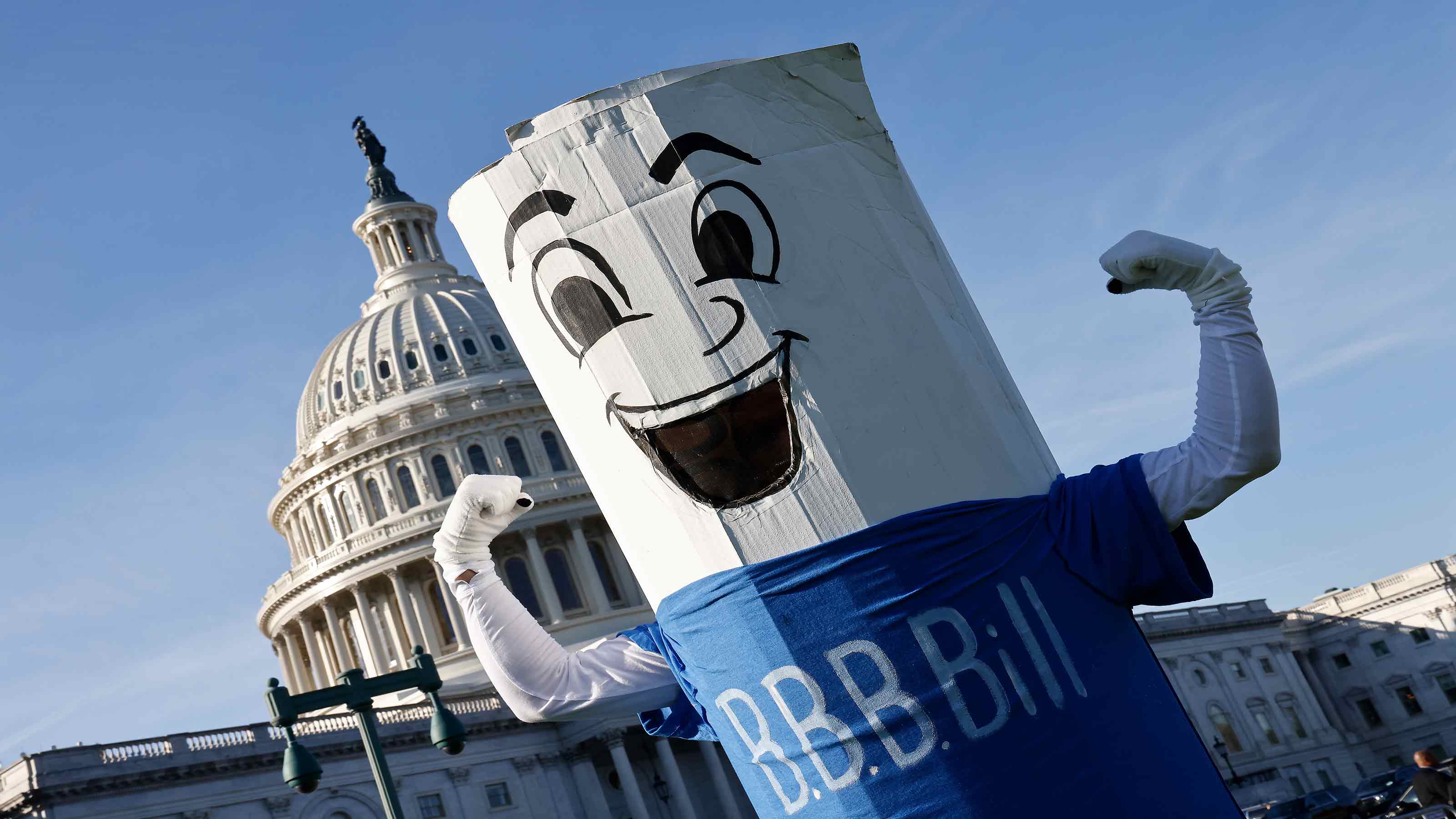Trump vs. Clinton: 10 Ways the Next President Will Impact Your Wallet
The policies that Democrat Hillary Clinton or Republican Donald Trump say they'll bring to the White House could have a dramatic impact on your wallet, your job, your health care and your retirement.
The policies that Democrat Hillary Clinton or Republican Donald Trump say they'll bring to the White House could have a dramatic impact on your wallet, your job, your health care and your retirement. Here’s where the two candidates stand on major economic and financial issues, with key differences in their approaches. We also threw in a few campaign quotes that help illustrate their views. Take a look:

Economic Growth and Jobs
- Key differences: Trump wants to pull back from worldwide economic engagement in pursuit of tougher trade deals and creating more jobs at home. His approach is similar in many ways to the Brexit vote to pull the United Kingdom out of the European Union. Clinton emphasizes economic development that relies on trade. And she supports more liberal immigration policies, which Trump opposes.
- Key Clinton quote: “We need to raise pay, create good paying jobs, and build an economy that works for everyone—not just those at the top.”
- Key Trump quote: “Americanism, not globalism, will be our credo. As long as we are led by politicians who will not put America First, then we can be assured that other nations will not treat America with respect. The respect that we deserve. Nobody knows the system better than me. Which is why I alone can fix it.”
- SEE ALSO: Kiplinger's Economic Outlooks
Trump's proposals are a radical departure from 100 years of Republican pro-business, free-market orthodoxy. He wants to force some American companies to bring their foreign manufacturing operations back to the U.S. from China, Mexico, Japan and Southeast Asia. To put Americans to work, he advocates a huge infrastructure rebuilding program at home (more on that later in the slide show), including building a wall along the Mexican border to stop illegal immigration. He says he'll deport all 11 million undocumented immigrants living illegally in the U.S. and place new restrictions on H-1B visas, which allow skilled immigrants to work in the U.S. for up to six years. Trump supports a federal minimum wage of $10. He wants to declare China a currency manipulator and impose huge tariffs on Chinese and Mexican imports “if they don’t behave.” Such threats concern economists, who worry that they will provoke a trade war and increase the likelihood of a global recession.
Where Trump waves a stick, Clinton favors a carrot approach: She would create tax and economic incentives to entice multinationals to bring jobs back to the U.S. She supports creating a pathway to citizenship for undocumented immigrants living in the U.S., and supports the H-1B program. In accordance with the Democratic Party platform, Clinton would increase the federal minimum wage to $15 an hour from $7.25. She says trade has been a “net plus for our economy,” yet she opposes President Obama’s Trans-Pacific Trade Agreement. Economist Chris Farrell worries that neither candidate is embracing retraining and financial support for workers who have lost their jobs to international competition. “Yes, protectionism is wrong. But so is not sharing the bounty from freer trade with those on the losing side of trade liberalization,” Farrell says.

Taxes
- Key differences: Clinton’s plan would increase taxes on the wealthiest Americans. Trump’s would cut taxes across the board — from the lowest-income earners to the top 1%. Key Clinton quote: “I want to make sure the wealthy pay their fair share, which they have not been doing.”
- Key Trump quote: “Middle-income Americans and businesses will experience profound relief, and taxes will be greatly simplified for everyone. I mean everyone. […] Reducing taxes will cause new companies and new jobs to come roaring back into our country.”
- SEE ALSO: Where Do You Rank as a Taxpayer?
Under Clinton’s plan, taxes would change slightly or not at all for the bottom 95% of taxpayers, while the top 1% would see sizable increases. This is because Clinton wants to implement a 4% surcharge tax on income over $5 million, plus the Buffett Rule, which would ensure that individuals who earn more than $1 million annually pay a minimum effective tax rate of 30%. Clinton’s tax plan would also cap the value of itemized deductions at 28% for folks in higher brackets. This limitation would apply to other tax breaks, too, such as the write-off for IRAs and moving expenses. And it would nick some currently tax-free items, such as 401(k) payins, tax exempt interest, and the value of employer-provided medical insurance. Finally, her plan would increase estate taxes, and place higher taxes on multinational corporations.
In a speech at the Detroit Economic Club on Aug. 8, Trump modified his proposal for overhauling the tax system.He still wants individual rate cuts, but they’re not as deep as in his original plan. Many said his first plan, with four brackets topping out at 25%, was too costly. Now he sees three brackets, maxing out at 33%, the same as the House GOP plan.
He continues to offer up a 15% rate on corporations and pass-throughs, such as partnerships and LLCs, and would extend the rate to sole proprietors. He favors full expensing for new asset purchases such as buildings and equipment. And he wants to do away with the estate and gift tax.
He’s silent on capital gains for now. His prior plan called for rates from 0% to 20%, compared with a 16.5% top rate under the House GOP blueprint. Also, he gives no details about which write-offs will be on the chopping block. He’ll probably keep breaks for home mortgage interest and donations to charity. But most others would have to disappear to help offset the cost of his proposed rate cuts..
Says Roberton Williams of the Urban-Brookings Tax Policy Center: “The Clinton plan is basically stay as you go. You’ve got a basic tax plan in place right now. She has so far proposed no major changes to that structure other than to raise taxes significantly on some high income people. That’s not a very radical change. Trump’s changes are much bigger.”

Health Care
- Key differences: Clinton supports the Affordable Care Act and wants to expand on Obamacare. Trump wants to repeal the ACA and has suggested letting private plans operate across state lines.
- Key Clinton quote: “When Americans get sick, high costs shouldn’t prevent them from getting better. With deductibles rising so much faster than incomes, we must act to reduce the out-of-pocket costs families face.”
- Key Trump quote: “We have a disaster called the big lie: ObamaCare [...]You have to be hit by a tractor, literally, to use it, because the deductibles are so high, it's virtually useless.”
- SEE ALSO: 50 Ways to Cut Your Health Care Costs
Clinton’s health care platform builds on President Obama’s landmark law by seeking to lower out-of-pocket and prescription-drug costs. To make premiums more affordable, she backs a tax credit of up to $5,000 per family to cover costs exceeding 5% of household income. She also wants to cap Obamacare premiums to no more than 8.5% of household income. Clinton’s other health care proposals include expanding access regardless of immigration status, making enrollment easier, and supporting a “public option” that would create a government health insurance agency to compete with private companies.
Like most Republicans, Trump wants to repeal Obamacare. He also wants to allow individuals to shop for private medical coverage across state lines in an effort to encourage competition and drive down costs. Trump has called for letting consumers fully deduct health insurance premiums from their tax returns and expanding the use of tax-exempt health savings accounts. These HSAs could accumulate tax-free contributions and become part of individuals’ estates, so they could be passed on to heirs without tax penalty.

Social Security and Medicare
- Key differences: Clinton would expand Social Security benefits for women who are widows and caregivers, and let individuals over age 50 or 55 buy into Medicare. Trump has pledged to preserve Social Security and Medicare throughout his campaign, but in recent weeks his advisers have hinted at entitlement cuts to keep both programs solvent in the future.
- Key Clinton quote: “Rather than expand benefits for everyone, I do want to take care of low-income seniors who worked at low-wage jobs. I want to take care of women. [...] I want to start by helping those people who are most at risk.”
- Key Trump quote: “We have to make our country rich again so we can do that, so we can save Social Security. Because I’m not a cutter. I’ll probably be the only Republican that doesn’t want to cut Social Security.”
- SEE ALSO: 10 Things You Must Know About Social Security
Social Security is at a critical point. By 2019, interest rates won’t be enough to close the funding gap, and without further reforms, payments will be cut by 21% in 2034. Clinton opposes privatization of Social Security. She would expand coverage to people who leave the workforce to care for children or sick family members. She also wants to increase benefits for widows who face steep benefit cuts when their spouses die. To pay for it all, Clinton would increase taxes on high earners, adding $11 trillion to the Social Security benefits account and keeping the program in the black for another 75 years.
Trump has repeatedly said that he won't cut Social Security. His plan to fund benefits is to create new jobs that generate more payroll taxes. In May, however, Trump adviser Sam Clovis hinted at potential entitlement cuts, saying, “After the administration has been in place, then we will start to take a look at all of the programs, including entitlement programs like Social Security and Medicare [...] to start seeing what we can do in a bipartisan way.” Trump’s position contrasts with that of many Republicans, who hope to decrease payouts over time by raising the retirement age or calculating cost-of-living adjustments in a less generous manner.
Clinton’s main Medicare proposal is a new program called “Medicare for More.” Under her plan individuals over 50 or 55 would be able to buy into Medicare, which could lead to a better distribution of costs. Medicare for More could cover an additional 13 million Americans, including seven million uninsured individuals. Clinton’s other Medicare proposals include driving down prescription-drug costs for seniors, and endorsing “bundled payments” that allow individuals to make one payment for care rather than pay multiple providers involved in treatment.
Trump has said he won't cut Medicare, but this claim contrasts with more recent statements by Clovis.

Climate Change
- Key differences: Couldn’t be starker. Clinton believes in the science of climate change. Trump rejects it. Clinton wants to invest in a clean energy infrastructure to diminish burning of fossil fuels. Trump wants to free up more exploration and development of fossil fuels, including coal.
- Key Clinton quote: “If we were the clean energy superpower of the 21st century, we would create millions of new good jobs and businesses, and we would transition away from fossil fuels and help the climate at the same time.”
- Key Trump quote: “I think our biggest form of climate change we should worry about is nuclear weapons. The biggest risk to the world, to me — I know President Obama thought it was climate change — to me the biggest risk is nuclear weapons.”
Clinton's goal is to see 500 million solar panels installed in the U.S. by the end of her first term, generating enough renewable energy to power every home in the country and reducing oil consumption by one-third. She also wants to launch a $60 billion Clean Energy Challenge that would aid sustainable energy efforts in states, cities and rural communities. Economist Kenneth Gillingham at Yale University’s School of Forestry and Environmental Studies says that her goals are highly ambitious. They assume that each home system has 25 200-watt solar panels. There now are about 1 million households in the U.S. with solar panels, and according to the Office of Energy and Renewable Energy, installations have grown to an estimated 30 gigawatts — enough to power 5.7 million homes. “Given that there are 125 million households in the United States in 2015, having roughly 20 million with solar panels by 2021 doesn’t sound absolutely crazy,” Gillingham says, “but it would be an incredible market growth over what we have today."
Trump scoffs at climate change. He would cut funding to the Environmental Protection Agency, stop sending tax dollars to United Nations global warming programs, and withdraw from the Paris Agreement (an international pledge to lower emissions). According to Gillingham, leaving the Paris Agreement could have a big impact. “The Paris Agreement is likely to lead to real reductions in greenhouse gas emissions around the world,” he says. “Many of these would happen regardless of what the United States does, but some likely will not, and any additional new efforts to address climate change would hit a brick wall.”
Trump has also set a goal of achieving American energy self-sufficiency if he is president. But Gillingham and other experts note that global energy markets thrive on trade, not energy independence. Gillingham says, “The thought of the United States leaving these [import and export] markets altogether is absurd and would leave billions of dollars on the table, most likely hurting both U.S. consumers and domestic oil and gas producers.”

Infrastructure
- Key differences: Both candidates say they want to invest in America’s crumbling roads, bridges, tunnels and transit systems. Clinton has a $275 billion plan that includes expanding networks for free broadband access. Trump has only made suggestions regarding a “trillion-dollar rebuilding plan.”
- Key Clinton quote: “I don’t have to tell you what a sorry state we’re in. Our roads and bridges are potholed and crumbling. Families endure blackouts because our electric grid fails in extreme weather. Beneath our cities, our pipeline infrastructure — our water, our sewer, you name it — is up to a century or more old. Our airports are a mess. Our ports need improvement. Our rail systems do as well.”
- Key Trump quote: “In my opinion, we’ve spent $4 trillion trying to topple various people. If we could’ve spent that $4 trillion in the United States to fix our roads, our bridges, and all of the other problems — our airports and all of the other problems we’ve had — we would’ve been a lot better off.”
- SEE ALSO: The Nation's Crumbling Infrastructure: 6 Examples in Need of Upgrades Right Away
Clinton’s main focuses include maintaining and rebuilding roads, bridges, public transit and airports, as well as extending Wi-Fi access in public spaces across America. Her five-year, $275 billion plan earmarks $25 billion for a national infrastructure bank that would encourage further public and private investment. The ultimate goal: generating $500 billion in funding. To pay for her proposal, the Democratic candidate would clamp down on tax shelters for offshore corporate profits. According to a report by the American Society of Civil Engineers, America’s infrastructure deficit is $1.6 trillion, meaning that Clinton’s plan would fail to cover even half of the estimate of the funds necessary to fully repair the nation’s framework.
Trump has alluded to a “trillion-dollar rebuilding plan” that, in dollar terms, comes closer to hitting the $1.6 trillion deficit mark reported by the ASCE. Citing a Senate Budget Committee estimate of job growth from infrastructure investment, Trump claims his plan would create 13 million jobs. Like Clinton, Trump wants to improve America’s roads, bridges, airports, rail systems and more. He believes his experience in the real estate industry would allow him to rebuild the country’s infrastructure “on time and under budget.” Trump hasn't explained how he would fund his proposals or one of his most widely cited campaign promises: building a wall between the U.S. and Mexico. Without factoring in the diplomatic challenges of erecting such a wall, Trump’s estimates of $4 to $12 billion in construction costs fall short of experts’ estimates of closer to $25 billion, plus $750 million a year for maintenance.

Student Debt
- Key differences: Both Clinton and Trump say they want to reduce the rising levels of student loan debt on college graduates, but their methods differ.
- Key Clinton quote: “No family and no student should have to borrow to pay tuition at a public college or university. And everyone who has student debt should be able to finance it at lower rates.”
- Key Trump quote: “We’re going to work with all of our students who are drowning in debt to take the pressure off these young people just starting out in their adult lives. Tremendous problem.”
- SEE ALSO: 10 Colleges That Don't Require Student Loans
Clinton supports more federal help for students at public colleges and universities, free community college, and better rates and repayment plans for those with student loans. By 2021, her New College Compact Plan would allow students from households earning up to $125,000 a year to qualify for free in-state public school tuition, as long as families make some contributions to college costs and students work 10 hours per week. It would also let all borrowers automatically delay payments on federal loans for three months, refinance loans at the same rates as new student borrowers, and use an income-based repayment plan that guarantees borrowers don’t pay more than 10% of their income. Clinton says she would fund these proposals by raising taxes on the wealthy and closing tax loopholes.
Trump hasn’t detailed a plan to address rising levels of college debt. (At a Wisconsin town hall meeting, he said, “We’re going to do something for the students. We’re going to have something with extensions and lower interest rates and a lot of good things.”) But he has been outspoken about his belief that the government should not profit from loans. Trump adviser Clovis has stated that Trump opposes Clinton’s plan for debt-free higher education because there is no way to pay for it. Instead, he wants to increase the role of private banks in offering loans.

Paying Down the Public Debt
- Key differences: Trump has proposed cutting the $19 trillion U.S. debt by giving bondholders less than the face value of the money owed to them. Clinton doesn't have a specific plan for paying down the national debt, although she would pay for new programs by raising taxes on the wealthy. Neither candidate has put forth a plan for paying down the debt.
- Key Clinton quote: "If you look at the evidence at the end of Bill Clinton’s two terms, we had the longest peacetime expansion in American history, with 22 million new jobs, a balanced budget and a surplus that would have paid off our national debt had they not been so rudely interrupted by the next administration.”
- Key Trump quote: “I would borrow, knowing that if the economy crashed, you could make a deal.”
Both the Clinton and Trump budget plans would increase U.S. debt over a 10-year period, according to an analysis by the nonpartisan Committee for a Responsible Federal Budget. Clinton’s proposals would increase debt by $250 billion, while Trump’s would increase debt by $11.5 trillion. Although both candidates have acknowledged the seriousness of America’s current and future fiscal state, neither has suggested a feasible plan to address the issue.
Clinton doesn’t have an official platform regarding debt. She contends the U.S. wouldn’t be facing a debt crisis if her husband’s efforts had been continued by the administration of his successor, George W. Bush. She would offset increased spending in areas such as infrastructure, energy and higher education by raising taxes on the wealthy. However, in order to keep U.S. debt from rising further after enacting these proposals, the CRFB estimates that Clinton would also need to cut total spending by 6% to 15%, increase all tax rates by 3.5% to 8.5%, accelerate annual real gross domestic product growth by 35% to 125%, or use a combination of the three strategies.
Trump’s campaign website doesn’t provide any details for paying off the national debt, but he has shared several ideas. One that created controversy during the GOP primaries involves paying bondholders less than the face value of the money owed to them. Economists have widely ridiculed the plan, saying it would likely backfire because 55% of the country’s debt is held by Americans, who hold bonds in their 401(k)s and pension plans. Paying these citizens less than their due would hurt retirement prospects, as well as the stablility of U.S. Treasury bonds. As the CRFB advises in its report, Trump’s more realistic options are cutting federal spending, increasing taxes and encouraging economic growth.

Defense Spending
- Key differences: Neither candidate seems to want to cut current levels of defense spending, but Clinton is focused on reallocating priorities and resources, while Trump hopes to make other countries pay more for maintaining worldwide alliances.
- Key Clinton quote: “I think we are overdue for a very thorough debate in our country about what we need, and how we are going to pay for it.”
- Key Trump quote: “We will completely rebuild our depleted military, and the countries that we protect, at a massive cost to us, will be asked to pay their fair share.”
- SEE ALSO: 8 Amazing New Military Technologies
The Democratic nominee has no official position on the defense budget, but she has called for a commission to investigate military spending. Given her more hawkish reputation relative to President Barack Obama, and goals such as maintaining a robust presence in the Middle East, building a cutting-edge military and defeating ISIS, experts believe that Clinton would likely maintain current defense spending levels. She would also use the defense budget to tackle related national security issues, including cybersecurity and fighting infectious diseases.
Trump hasn’t explicitly stated how much he would spend on defense, either, but he has laid out a goal of making the military so strong that “nobody’s going to mess with us.” He thinks the current budget could be used more efficiently. One of Trump’s ideas for curbing defense spending is making America’s allies pay for common defense. This would force countries such as Germany, Japan and South Korea to pay a higher price for U.S. military support.

Dependent Care
- Key differences: Trump wants a new tax deduction for families with up to four children or for providing care to elderly relatives. Clinton wants a 10% household income cap on child care expenses.
- Key Clinton quote: "I don't think any family should have to pay more than 10% of their income for child care.”
- Key Trump quote: "We need working mothers to be fairly compensated for their work, and to have access to affordable, quality child care for their kids."
- On Sept. 13, 2016, Trump proposed allowing families to deduct child-care expenses, up to the average cost of child care in their state. Parents who itemize as well as those who claim the standard deduction would be able to claim this tax break.
- Trump has proposed guaranteeing six weeks of maternity leave to mothers who don't already receive paid leave from their employers. His plan, which he says would be paid for by eliminating fraud in the unemployment insurance program, would be limited to mothers.
- Clinton wants to provide up to 12 weeks of guaranteed leave for workers who need to take time off to care for a new child or seriously ill family member. Under her plan, workers would receive up to two-thirds of their current wages, up to a ceiling, while on leave. She would increase taxes on the wealthiest taxpayers to cover the costs of the program.
There would be income caps for the wealthy under Trump's plan. Couples with income of more than $500,000 and individuals with income exceeding $250,000 would be ineligible. Families could claim the tax break for up to four children; it would also be available for taxpayers with elderly dependents.
Trump also wants to create a new savings plan that would allow parents to make tax deductible contributions to an account to pay for child care, after-school programs and private school tuition. Accounts set up for elderly dependents could be used for in-home nursing care, long-term care and other services.
Under current law, flexible spending accounts allow parents to put aside pre-tax money for child care, but these accounts are only offered through employers and qualified expenses are more limited than those permitted by Trump's plan.
In addition, money saved in FSAs must be used by year-end (or the following first quarter). Trump's plan would allow savers to carry over unused balances.
Trump would also allow caregivers to claim an above-the-line deduction of up to $5,000 to cover home health care, adult day care or similar services for an elderly family member.
Clinton has proposed capping child care costs at 10% of a family's income. The program would involve federal subsidies for low-income families and tax breaks for middle-income parents. (Clinton hasn't provided specifics on how this tax relief would work.) Clinton also wants to provide financial aid to the nearly 5 million college students who are raising children while attending school. Clinton wants to provide those students with scholarships of up to $1,500, which could be used for child care, transportation or emergency financial aid.

Best Stocks for the Next President
We've picked stocks that could pop under a Trump or Clinton presidency.
In searching for potential beneficiaries of a Trump presidency, we examined the candidate’s statements and positions on energy, immigration, free trade and more. For our picks under a Clinton presidency, we had a better chance of anticipating how various industries might be affected because Clinton has been in politics longer and has released a greater number of official policy positions than Trump.
Profit and prosper with the best of Kiplinger's advice on investing, taxes, retirement, personal finance and much more. Delivered daily. Enter your email in the box and click Sign Me Up.

-
 How Much a $100k Jumbo CD Earns You
How Much a $100k Jumbo CD Earns YouYou might be surprised at how fast a jumbo CD helps you reach your goals.
-
 How Charitable Trusts Benefit You and Your Favorite Charities
How Charitable Trusts Benefit You and Your Favorite CharitiesThese dual-purpose tools let affluent families combine philanthropic goals with advanced tax planning to generate income, reduce estate taxes and preserve wealth.
-
 A 5-Step Plan for Parents of Children With Special Needs
A 5-Step Plan for Parents of Children With Special NeedsGuidance to help ensure your child's needs are supported now and in the future – while protecting your own financial well-being.
-
 32 Ways to Make Money in 2025
32 Ways to Make Money in 2025business Check out these cool side hustles to earn bonus bucks this year.
-
 12 IRS Audit Red Flags for the Self-Employed
12 IRS Audit Red Flags for the Self-Employedtaxes If you are self-employed, minimize the odds of an IRS audit by avoiding these audit triggers.
-
 Business Cost Outlooks for 2022: Eight Key Sectors
Business Cost Outlooks for 2022: Eight Key SectorsEconomic Forecasts What’s in store for all sorts of business costs in 2022?
-
 PPP Loan Basics for Small Business Owners
PPP Loan Basics for Small Business OwnersCoronavirus and Your Money Although uncertainty and confusion have surrounded the Paycheck Protection Program since its launch, that shouldn't stop small business owners from participating in the loan program, which was just extended to May 31.
-
 "Above-the-Line" Deductions for Your 2021 Tax Return
"Above-the-Line" Deductions for Your 2021 Tax ReturnTax Breaks If, like most people, you claim the standard deduction instead of itemized deductions on your return, there are still many other tax deductions available that could save you a lot of money.
-
 The Biden Tax Plan: How the Build Back Better Act Could Affect Your Tax Bill
The Biden Tax Plan: How the Build Back Better Act Could Affect Your Tax BillPolitics Depending on your income, the Build Back Better Act recently passed by the House could boost or cut your future tax bills.
-
 9 Tips for Better Time Management in Retirement
9 Tips for Better Time Management in Retirementretirement These important time management techniques will help destress your life as you get busier -- yes, busier -- in your golden years.
-
 7 Ways PPP Loans Just Got Better
7 Ways PPP Loans Just Got Bettersmall business loans The Paycheck Protection Program Flexibility Act makes a number of changes to the popular small-business loan program. See how your business might benefit from the improvements.


